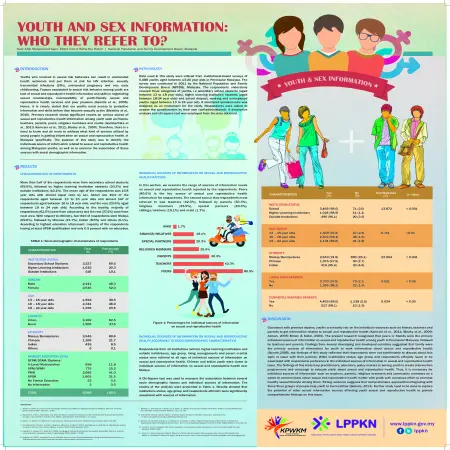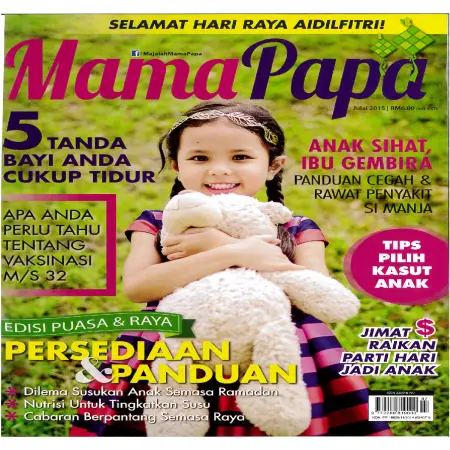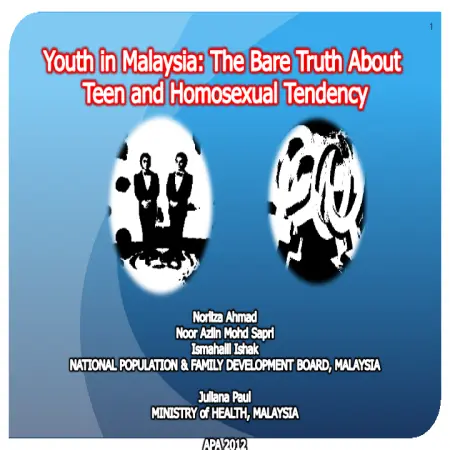Browse by Type
|
|
Youth and sex information: who they refer to?
Item Type: Scientific Poster
Editor:
Year: 00/07/2015
Abstract: Youths who involved in sexual behaviors can result in unintended health outcomes and put them at risk for HIV infection, sexuality transmitted infections (STIs), unintended pregnancy and very early childbearing. Factors associated to sexual risk behavior among youth are lack of sexual and reproductive health information and skills in negotiating sexual relationships, inaccessibility of youth-friendly sexual and reproductive health services and peer pressure (Kaestle et Al., 2005). Hence, it is clearly stated that our youths need access to protective information and skills before they become sexually active (Bleakley et al., 2010) Previous research shows significant results on various source of sexual and reproductive health information among youth such as friends, teachers, parents, peers, religious members and media (Gombachika et al.,2013; Kamrani et al., 2011; Bleaky et al., 2009) therefore, there is a need to know and do more address what kind of sources utilized by young people in getting information on sexual and reproductive health, in Malaysia specifically. The purpose of this study was to identify the individuals source of information related to sexual and reproductive health among Malaysia youth, as well as to examine the association of these sources with social demographic information.
|
|
|
|
|
|
Yang mana satu pilihan: keluarga kecil atau besar
Item Type: Article
Editor:
Year: 10/07/2015
Abstract: In the current of modernization, many couples are planning to limit the number of their family members. Among the factors that push them to plan a family are getting married at a late age and the rising cost of living. The practice of family planning is very helpful in determining the birth distance between children and the size of the appropriate number of children for a family. This contraceptive practice can also prevent pregnancy in high-risk women, i.e. women with serious health problems or hereditary diseases.
|
|
|
|
|
|
Youth in Malaysia: the bare truth about teen and homosexual tendency
Item Type: Conference or Workshop Item
Editor:
Year: 01/07/2012
Abstract: Sexuality is a result of the interplay of biological, psychological, socio-economic, cultural, ethics and religious/spiritual factors. Youth sexuality, particularly homosexuality has always been a matter of concern to many parties. Furthermore, the issue of homosexuality has already caused much controversy in Malaysia recently. This study aims to explore the homosexual tendency among Malaysian youths. Methods a nationwide cross sectional study was done using secondary data from Adolescent Health Screening Forms (BSSK/R/1/2008). Data was obtained from randomly selected participants of a national youth programme aged between 18-25 years and was analyzed using SPSS. Results A total of 22,750 youth participated with almost equal ratio by sex. Mean age was 19.0 years old. This study revealed that the homosexual tendency was more common amongst male youths (4.1%), 21-24 years old (5.5%) and no formal education (6.1%). There is a relationship between homosexual tendency and sex, ethnicity and educational attainment. Homosexual tendency was found to be significantly associated with risky behavior, abuse, anti-social behavior, substance abuse and family connectedness. Multivariate analysis using logistic regression found that homosexual tendency was two times higher among abused youth followed by youth with anti-social (OR=1.9), risky behavior (OR=1.6), lack of family connectedness (OR=1.7), less religious (OR=1.4) while controlling for age, ethnicity and education level. Conclusion, the prevalence of homosexual tendency among youths in Malaysia is an alarming issue and many cases are still under-reported. Misunderstanding and a lack of information on sexual diversity have caused a concern for many, as there is a tendency for judgments, stereotypes, discrimination and prejudice towards homosexuality in society. Instead of treating it as a disease, ways and measures of educating youths need to be explored.
|
|
|
|







